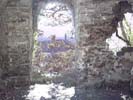
The University of Stirling opened in 1967 on the Airthrey estate and is regarded by many as the most beautiful campus in the country. The 363 acre grounds and man-made loch were designed by Thomas White for the Haldane family in the late 18th century. Airthrey Castle itself was built to a design by Robert Adam. Grapes were grown in the estates own vineries, during the 19th century.
Since forming in 1970, the Airthrey Gardens Group have raised money to transform the grounds by planting thousands of colourful flowers, trees and shrubs and developing two scenic walks. The beauty of the campus owes a great deal to their efforts.
Beside Airthrey castle, you can play a round on the nine hole golf course. At the back of the course, look over the trees towards the Hillfoots and you will see two standing stones about 8 to 9 feet high. The stones bear no inscription and it is believed that they commemorate the site of a battle in 843 AD when, the Scots under King Kenneth MacAlpine defeated the Picts. The Stone may be linked to this event and the uniting of both races.
The campus is open to the public all year round and worth visiting for a stroll around the loch. The loch was popular with curlers and ice skaters until an accident on the loch in 1901, when the ice broke and two people were drowned. Covered with daffodils in Spring and rhododendrons in Summer, with the constantly changing colours of the Ochill Hills as a backdrop.
From the back of the university, you can access the Hermitage Woods and try to find the Hermitage itself. Frequent buses run all day from Murray Place bus stop in town to the university.
University of Stirling website
Spend a few hours on the most beautiful campus in the country and visit Stirling University Art Collection, one of the finest and least well known art collections in the country.
When Stirling University was founded, the first Principal was Tom Cotterell. A scientist by training, he came from an artistic background and had very clear ideas about art and its place in society. He felt that art should be part of the everyday experience at the University.
It was this philosophy that prompted the early decision to budget for works of art to enhance the developing campus and 1% of the cost of each new building was earmarked for art to decorate it in the first phase of University building.
It is this philosophy that has been driving and inspiring the university to keep on collecting and showing exciting art to the public ever since. The majority of Stirling University Art Collection can be found in the Pathfoot Building although art and sculpture are dotted all around the campus. The Pathfoot building itself, is an outstanding example of post-war Modernist architecture that sits perfectly on the landscape of the old Airthrey estate. At the University art is still a part of everyone's lives, whether you are studying here or simply visiting. Find out all about the collection and current exhibitions at Stirling art
Stirling University was the only "New University" to be built in Scotland and was part of the wider government agenda to develop and expand tertiary education near small urban centres across the UK. Stirling was chosen along with Sussex, Warwick, Kent, York, Essex, Lancaster, East Anglia, all of which were set in parkland. The planning and design of Stirling University benefited from being conceived in the later 1960s once lessons of the first university schemes had been learned. For example, at Stirling, the perceived elitist agenda of the first schemes modelled on the Oxbridge formula of cloisters and segregated social and departmental areas (as pre-conceived by a master-plan), had expanded to a completely flexible, non-rigid set of buildings which could accommodate shifting patterns of inter-departmental teaching and allow for more casual social interaction among the student population.
Pathfoot was the first building designed and built for the University of Stirling and from its inception was meant to house all the new institution's needs before the rest of the campus, the social and teaching buildings and the rest of the residences, was completed.
Pathfoot was completed in time for the opening semester in 1967, less than a year after ground was broken. Part of its success was due to the unique prefabricated building system developed by the practice which could be assembled in any order and the floor was not dependent on the framing system. This innovation was a milestone in construction terms for the Edinburgh practice and would influence their design and building process at Aberdeen and Edinburgh airports.

Overgrown and hidden away on the hillside, almost in a line with Airthrey Castle, the Hermitage can be hard to locate and is easy to miss. The Hermitage woods are a good spot for a short stroll or as part of a longer walk up to Sherrifmuir or Dumyat. This dense, mixed woodland is rich with plants, wild flowers and wildlife. The woods back on to the residences and the grounds of Stirling University which, is sited on the old Airthrey estate.
For a good walking route see our detailed walk through the Hermitage Wood.